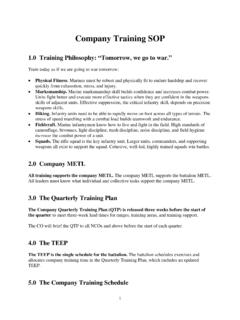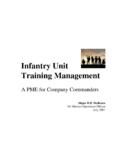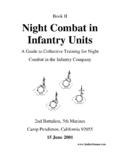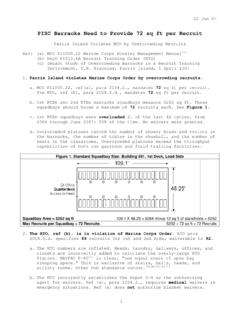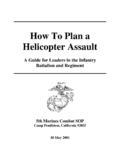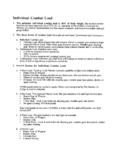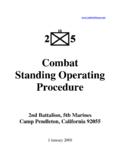Transcription of How To Train - 2ndbn5thmar.com
1 How To Train Your Squad A training Guide for Infantry Squad Leaders Lieutenant Obalde USMC May 1998 Updated 2001 Table of Contents What are My training Responsibilities? Section 1 What are My training Responsibilities? 1-1 Who Supports Me? 1-2 Guidelines for training 1-3 What Tools Support My training ? Section 2 What training Needs to be Done? 2-1 What are Individual Skills? 2-2 What are Collective Tasks? 2-3 How Do I Use References? 2-4 How Do I Conduct training ? Section 3 How Do I Train Individual Skills? 3-1 How Do I Train Collective Tasks? 3-2 How Do I Conduct Leadership training ? 3-3 How Do I Evaluate My Squad? 3-4 What is Opportunity training ? 3-5 Tips for training 3-6 This booklet was prepared in accordance with the following publications: MCRP 3-0A Unit training Management Guide Washington, , HQ USMC, November 1996 MCRP 3-0B How to Conduct training Washington, , HQ USMC, November 1996 FM 25-101 Battle Focused training Washington, , Department of the Army, September 1990 Section 1 What are My training Responsibilities?
2 What are My training Responsibilities? Train Your Marines. As a Squad Leader, you must Train the Marines you lead. Everything you do should prepare your squad for combat. Train Individual Skills. Train your Marines to perform Individual Skills. You are the primary trainer for the Individual Skills of your Marines. Train Collective Tasks. Along with the other commanders in your chain of command, you Train your squad to execute Collective Tasks. Train Your Fireteam Leaders. In combat, all leaders must be prepared to command units one level above their own. Train your fireteam leaders to command the squad in your absence. Train Yourself. The Squad Leader is the Primary Warfighter in the Marine Corps. You must be a Tactician, a Decisionmaker, and a Leader. You need to be well-educated and well-trained. In addition to formal schooling, you must take the initiative to Train yourself. You must be a self-learner and a self-starter. Who Supports Me? As a Squad Leader, you execute the training plan.
3 Ideally, you can expect the following support: At the Platoon Level. The Platoon Commander is responsible for all platoon training . He assigns squad tasks and establishes platoon Standing Operating Procedures (SOPs). The Platoon Commander will lead live-fire, field training , and supporting arms exercises. The Platoon Commander is the primary evaluator for the combat readiness of your squad. Your Platoon Sergeant will assist you in conducting and evaluating your training . He will also help you determine what resources you need for training . As a former Squad Leader, your Platoon Sergeant has experienced the same challenges you now face. Seek his advice and ask him questions. His experiences have taught him what works and what does not. At the Company Level. The Company Commander is responsible for all company training . He selects missions and creates the company training plan. The Company Commander is the primary evaluator for the combat readiness of his platoons.
4 The Company First Sergeant assists the Company Commander in evaluating his Marines. His experience and advice can be a valuable asset to your training . The Company Gunnery Sergeant handles all the logistical needs of the company. All training requests are addressed to him. As a former Squad Leader, the Company Gunnery Sergeant can advise you in training your squad. Guidelines for training You are responsible for ensuring that your training meets the following guidelines. Train as you Fight! Ensure realism. The combat environment is harsh, unforgiving and unpredictable. Simulate casualties, the loss of leaders, and bad communications. Train in difficult conditions. Train for Combat! Make training real and make it relevant. Your training must support your unit s missions. Train as a Combined Arms Team. Train as a unit. Maintain relationships with frequent attachments. Work and Train as units both in the field and in garrison. Train with the Marines you have.
5 In combat, you will never have all your Marines available every day. Train with those you have. Use Performance-Based training . Ensure your Marines can perform their tasks to standard. Train for mastery of the fundamentals. Train to standard, not to time. Marines learn best when they are trained by practical application. Train to Maintain Skills. Once proficiency is achieved, it must be maintained. Skills must be continually practiced. Train on All Levels at the Same Time. training should be progressive. Advanced training requires the execution of basic tasks. Collective training requires Marines to perform Individual Skills. Section 2 What Tools Support My training ? What training Needs to be Done? At the Company Level. The Company Commander selects a company-level mission and creates a training plan to prepare for this mission. He assigns each Platoon Commander multiple platoon missions to support the company mission. At the Platoon Level.
6 The Platoon Commander trains his platoon to execute his assigned missions. He assigns each Squad Leader the Collective Tasks and Individual Skills which the Marines must know to support the platoon mission. A single company mission may require four or five platoon-level tasks, twelve to twenty squad-level tasks, and possibly 75 to 100 individual tasks. At the Squad Level. The company training schedule indicates what training you will have to perform. Study the Collective Tasks and Individual Skills you have been assigned, and then decide what additional Individual Skills and Collective Skills will be required for your mission. Your squad may be tasked to act as guides for a night attack, conduct a daylight security patrol, and act as the point element of a movement to contact. These missions require training in many Individual Skills and squad Collective Tasks. For each Individual Skill, determine who needs the training . Some skills are required by all hands, while some skills are billet-specific.
7 Concentrate on common skills. Many Individual Skills are common to all of your missions. These skills have priority. Once they have been mastered, you can begin to Train for the skills that apply to a single mission. Eliminate Weak Links. After determining which skills will be required for upcoming missions, test your squad s proficiency at performing the tasks required by those missions. Concentrate training on tasks at which your squad is weakest. Recommend training . If the company training schedule does not support your training needs, or there is no time for squad training on the schedule, tell your Platoon Commander. The company training schedule needs your input. Ask for time! Ask your Platoon Commander for time to Train your squad. He knows that your training must succeed in order for his objectives to be met. You are providing the backbone of training for your Marines. Any time designated as NCO time can be used for training . Conduct training on your own time, outside the schedule, or after being released by the platoon.
8 Keep your Marines Informed. Tell your Marines when and where training will occur, and what will be expected of them, so they can prepare themselves. On the battlefield, knowledge is as powerful as firepower. The fighting spirit of your Marines requires information. What are Individual Skills? Individual Skills are those tasks performed by a single Marine. These basic skills must be mastered before more complex Collective Tasks can be attempted. Individual skills cover combat techniques as well as equipment and weapons. What are Individual training Standards? Individual training Standards (ITS) define performance standards for individual skills. Individual Skills for infantrymen are outlined in MCO , INDIVIDUAL training STANDARDS FOR THE INFANTRY (ENLISTED) OCCUPATIONAL FIELD (OCCFLD) 03. The ITS for a particular skill allow you to give proper instruction and then evaluate your Marines performance. ITSs describe the tasks to be performed, the conditions under which the task is to be performed, and the standard to be met.
9 The performance steps for the task are listed, as well as any administrative instructions necessary. Finally, a reference to a training manual is given. Example ITSs are: TASK ASSEMBLE THE AN/PRC-119 SINCGARS RADIO TASK TIE KNOTS TASK ZERO THE M249 SAW Commanders can adjust published standards to meet training requirements. For example, TASK , TIE KNOTS, requires mastery of thirteen knots. You may determine to Train your Marines on only four of these knots. Commanders can also adjust the conditions under which a task is to be performed. Marines familiar with a task should be expected to perform it under tougher conditions in the dark, in the rain, with less time. Marines just learning a task will perform it under easier conditions. Remember, when learning a task, the standard always remains the same. The conditions get tougher. ITSs for all Marines are outlined in MCO Ch1, INDIVIDUAL training STANDARDS (ITS) SYSTEM FOR MARINE BATTLE SKILLS training (MBST) VOLUME 1 - ENTRY LEVEL.
10 Individual skills for all NCO s and SNCO s are outlined in MCO , INDIVIDUAL training STANDARDS (ITS) SYSTEM FOR MARINE BATTLE SKILLS training (MBST) VOLUME 2 - CORPORAL THROUGH GUNNERY SERGEANT. These two training orders apply to the entire Marine Corps and all MOS s. These orders are only secondary sources for infantry training . The new MCO 3501 Marine Corps training and Readiness Manual for Infantry Units (T&R) will define individual training Standards for infantrymen. This manual will soon completely replace the What are Collective Tasks? Collective Tasks are team tasks. Collective Tasks require Marines to perform multiple individual tasks simultaneously for a single purpose. As a Squad Leader, you are responsible for training your Marines to work as a team. Efficient teamwork stems from your squad s experience in working together. Each Marine must know his individual tasks, and how these tasks fit into unit collective tasks. Squad Missions. The missions your squad receives are not standardized in any Marine Corps publication.
